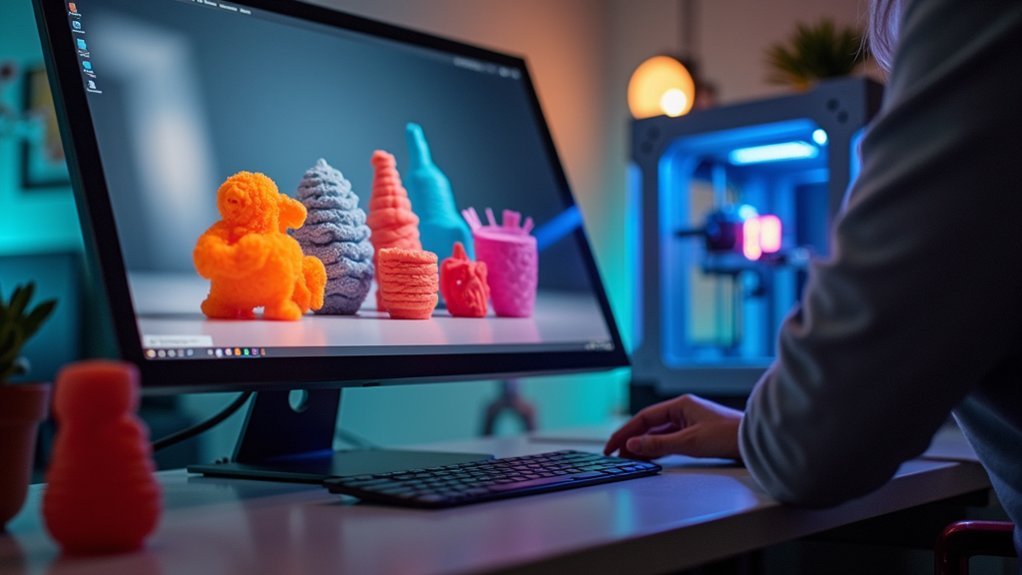You’ll find that MeshLab excels for professional mesh analysis and repair capabilities, while Autodesk Fusion 360 offers precise CAD-based spatial adjustments for complex merging tasks. Meshmixer provides the most user-friendly experience with intuitive positioning and automatic mesh repairs, making it ideal for beginners. PrusaSlicer supports direct drag-and-drop merging if you’re looking for a simple slicer-based solution. Your choice depends on technical expertise, file complexity, and whether you need advanced boolean operations for seamless integration.
Understanding STL File Merging Requirements

When you’re merging STL files, you’ll need software that can handle mesh analysis and repair to maintain the integrity of your combined model.
Effective STL merging requires robust software with mesh analysis and repair capabilities to preserve your model’s structural integrity throughout the combination process.
The most critical requirement is ensuring your meshes are closed, as open meshes will cause printing failures and complicate your final design. You’ll want tools that can combine multiple STL files through precise spatial alignment and positioning capabilities.
Boolean operations are essential for effective merging, particularly boolean union functions that seamlessly join separate models.
Software like Autodesk Meshmixer excels at this through its user-friendly interface and reliable boolean tools. Additionally, your chosen software must export the merged result as a new STL file, ensuring compatibility with 3D printing workflows and future design modifications.
MeshLab: Professional-Grade STL Merging Capabilities
Professional 3D mesh processing demands robust tools, and MeshLab delivers exactly that with its extensive STL merging capabilities. You’ll find this open-source software excels at combining multiple STL files while maintaining mesh integrity through advanced processing functions.
| Feature | Benefit |
|---|---|
| Simultaneous file handling | Efficient workflow for complex projects |
| Large file support | Stable performance with complex geometries |
| Advanced mesh tools | Error cleaning and remeshing capabilities |
When you’re merging STL files in MeshLab, you’ll access professional-grade visualization and manipulation tools that guarantee precise alignment. The software’s ability to handle large file sizes means you won’t encounter performance bottlenecks during intensive merging operations. You’ll also benefit from thorough analysis features that verify your merged models meet quality standards.
Autodesk Fusion 360: CAD-Based STL Combination

Autodesk Fusion 360 transforms STL merging from a mesh-only process into an all-encompassing CAD-based workflow that gives you parametric control over your combined models.
You’ll import multiple STL files simultaneously using the “Insert Mesh” function, bringing separate STL files into one workspace efficiently. The software’s precision tools let you make exact spatial adjustments, ensuring perfect alignment and positioning of each component.
You can select appropriate units during import, maintaining flexibility for your project requirements.
Fusion 360’s intuitive interface makes arranging and modifying your models straightforward, with enhanced accuracy tools for ideal placement. Once you’ve positioned everything correctly, you’ll export the merged result as a new STL file, ready for 3D printing.
It’s a good tool that combines professional CAD capabilities with mesh manipulation.
Meshmixer: User-Friendly Mesh Merging Solution
Since Meshmixer offers dedicated mesh editing capabilities without the complexity of full CAD software, you’ll find it’s an ideal solution for straightforward STL file merging tasks.
This free Autodesk software lets you import multiple STL files simultaneously and provides intuitive positioning tools for perfect alignment before combining.
You’ll need to use boolean operations to merge your models, creating complex shapes by fusing different files into a single entity.
Meshmixer automatically analyzes and repairs merged meshes, fixing common issues like holes or non-manifold edges to guarantee your model is 3D printing-ready.
Meshmixer’s automatic mesh analysis eliminates manual troubleshooting by detecting and repairing structural defects that could compromise your 3D print quality.
The built-in slicer tool streamlines your workflow by letting you prepare and send merged models directly to your 3D printer, eliminating additional software requirements.
PrusaSlicer: Direct Slicer-Based File Combination

You can streamline your 3D printing workflow by merging STL files directly within PrusaSlicer, eliminating the need for separate mesh editing software.
Simply drag and drop multiple STL files into the workspace, then right-click on your selected models to access the “Merge” option.
This approach lets you combine objects and generate G-code for the merged assembly in one seamless process.
Loading Multiple STL Files
PrusaSlicer offers one of the most straightforward approaches to loading and merging multiple STL files directly within the slicer interface. You can simply drag and drop your STL files into the main workspace, instantly importing them for arrangement and manipulation.
Alternatively, click the cube icon in the toolbar to add multiple files at once through the file browser.
Once loaded, select multiple models by holding the CTRL key while left-clicking each file. This batch selection method streamlines your workflow when handling numerous components.
After selecting your desired models, right-click to access the context menu and choose the “Merge” option. This transforms your separate STL files into a single unified object, optimizing build plate usage and reducing overall printing time considerably.
Merging Objects Together
After loading your STL files into PrusaSlicer’s workspace, the actual merging process becomes remarkably simple and efficient. You’ll right-click on your selected models to access the context menu, where you can merge them into a single object. This streamlined approach eliminates the need for separate CAD software.
| Merging Feature | Benefit |
|---|---|
| Right-click merge | Instant object combination |
| Visual arrangement tools | Ideal build plate usage |
| Multi-material support | Color-coded model sections |
Once merged, you can apply different colored filaments to various parts of your combined model, creating visual differentiation for multi-material printing. The software’s visual aids help you arrange components efficiently on the build plate. After merging, you’ll slice and export the entire assembly collectively, greatly simplifying your 3D printing workflow preparation.
Blender: Advanced Mesh Editing and Merging
When you need sophisticated control over mesh editing and merging operations, Blender stands out as a thorough open-source solution that handles complex STL file combinations with precision.
You’ll access powerful boolean modifiers that enable seamless integration of multiple STL files into cohesive models. While the interface appears complex initially, extensive tutorials and community support help you master the merging process effectively.
You’ll benefit from efficient mesh analysis and repair tools that resolve issues before finalizing your merged model.
Blender’s advanced capabilities extend beyond basic merging—you can apply materials and textures to different sections of your combined STL files, enhancing visual appeal for 3D printing projects.
This extensive approach makes Blender ideal when you require professional-grade mesh editing control.
FreeCAD: Open Source STL File Integration
FreeCAD delivers extensive parametric CAD functionality through its open-source platform, making STL file integration accessible without licensing costs.
You’ll find the Part workbench particularly useful for merging STL files, where boolean operations let you combine different meshes into cohesive objects seamlessly.
The software’s multi-format support enhances your workflow flexibility by integrating STL files with various CAD formats. You can perform mesh analysis and repair functions, ensuring your merged files are 3D printing ready without errors or defects.
FreeCAD’s active community provides valuable resources, tutorials, and plugins that’ll help you master STL integration techniques.
Whether you’re combining simple parts or complex assemblies, you’ll appreciate the software’s robust capabilities for creating unified models from multiple STL sources.
Boolean Operations for Seamless Model Combination
You’ll find boolean operations are essential tools for combining multiple STL files into a single, seamless model through union, intersection, and difference commands.
Before executing any boolean operation, you must first analyze and repair your meshes since damaged geometry will compromise the final result.
Understanding union operations specifically allows you to merge overlapping or adjacent STL files while maintaining proper mesh integrity throughout the process.
Union Operations Fundamentals
Before you can successfully combine multiple STL files into a cohesive 3D model, you’ll need to master union operations—the Boolean functions that seamlessly merge overlapping geometries into a single, printable mesh.
Software like Fusion 360 and Meshmixer offer these essential union functions, enabling you to integrate distinct shapes into one unified entity. You’ll achieve the best results when you properly align and overlap your models before executing the operation.
Misalignment creates gaps and non-manifold edges that’ll compromise your print. After completing union operations, you must analyze and repair the combined mesh to guarantee it’s watertight.
These operations also simplify complex models by reducing separate components, improving printability and minimizing print failures.
Mesh Repair Requirements
Successful boolean operations depend heavily on the quality of your input meshes, making pre-operation repair work a non-negotiable step in the merging process.
You’ll need to analyze each STL file for mesh integrity issues before attempting any union operations. Non-manifold edges and intersecting geometries are the primary culprits that’ll cause boolean operation failures.
Meshmixer’s autorepair functions excel at resolving common problems like holes, overlaps, and non-manifold edges that prevent successful merging.
You should run these diagnostic tools on every file first. Don’t skip the alignment phase either – proper positioning prevents unintended gaps or overlaps in your final model.
After completing boolean operations, inspect your merged model thoroughly for artifacts or irregularities that may have emerged during the process.
Mesh Analysis and Repair Before Merging
When working with STL files, analyzing and repairing mesh issues stands as a critical step that can make or break your merging success. Software like Meshmixer lets you identify problems such as non-manifold edges and holes before combining files.
You’ll want to use built-in repair tools that automatically analyze and correct common mesh problems, streamlining your preparation process.
Don’t overlook overlapping geometries—they’re notorious for causing failed merges or printing errors. Meshmixer’s auto-repair feature corrects detected errors efficiently, notably enhancing your merged model’s quality.
File Size Limitations and Performance Considerations
While merging STL files might seem straightforward, file size limitations can dramatically impact your software’s performance and determine whether your project succeeds or fails. Large files create significant processing bottlenecks, causing longer wait times and potential crashes that’ll derail your workflow.
| File Size Range | Performance Impact |
|---|---|
| Under 50 MB | Ideal performance, smooth processing |
| 50-100 MB | Good performance, occasional slowdowns |
| 100-250 MB | Noticeable delays, memory strain |
| 250-500 MB | Significant slowdowns, crash risk |
| Over 500 MB | High crash probability, processing failures |
Even robust software like Fusion 360 struggles with extremely large STL files due to memory limitations. Meshmixer’s user-friendly interface won’t save you from crashes when handling high-resolution meshes. Break down larger models into smaller components and save your work frequently to avoid losing progress.
Color Management for Multi-Material Printing
Once you’ve merged your STL files, color management becomes essential for multi-material printing projects that demand visual clarity and functional distinction.
You’ll need to assign different filament colors to each part in your merged model, which enhances visual differentiation during printing. Slicer software like PrusaSlicer lets you manage these configurations through AMS setup, enabling efficient loading and purging of different filaments.
Beyond aesthetics, distinct colors provide functional benefits by indicating different material properties or component functions. However, you must consider filament behavior since different colors may require specific temperature settings or print speeds for ideal results.
- Red housings paired with transparent windows for electronic enclosures
- Color-coded mechanical parts showing stress distribution or assembly order
- Contrasting support materials that simplify post-processing removal
Export Settings for Combined STL Models
When you’re ready to export your merged STL model, you’ll need to choose the right file format and configure quality settings that match your 3D printing requirements.
Your export format selection directly impacts compatibility with different slicing software and printers, while quality settings control the mesh resolution and final print detail.
Getting these settings right guarantees your combined model maintains structural integrity and prints successfully without mesh errors or dimensional issues.
File Format Options
After successfully merging your STL files, you’ll need to configure the proper export settings to guarantee your combined model maintains its integrity and prints correctly.
Different software platforms offer varying format options beyond standard STL exports. You’ll want to evaluate which format best suits your 3D printing workflow and hardware requirements.
- STL Format: The most universal option, supported by virtually all 3D printers and slicing software, though it only contains mesh geometry data.
- Gcode Export: Available in PrusaSlicer for direct printer communication, eliminating the need for additional slicing steps after merging.
- Mesh Resolution Settings: Adjustable in most software to balance file size with surface detail quality for ideal printing results.
Choose your export format based on your printer’s capabilities and post-processing requirements.
Quality Settings Control
While your merged STL files may appear perfect on screen, controlling quality settings during export determines whether your 3D prints will succeed or fail.
You’ll need to balance file size with mesh quality when exporting combined models. Choose “Binary” format over “ASCII” to reduce file storage and transfer times considerably. Adjust resolution settings carefully—higher resolution creates finer meshes but generates larger files.
| Setting | Low Quality | Medium Quality | High Quality |
|---|---|---|---|
| File Size | Small | Moderate | Large |
| Print Detail | Basic | Good | Excellent |
| Processing Time | Fast | Medium | Slow |
| Storage Space | Minimal | Moderate | High |
Always verify your modifications are saved before exporting, and select appropriate units during the export dialogue. After exporting, run mesh analysis tools to verify your combined STL is manifold and print-ready without errors.
Troubleshooting Common Merging Issues
Although STL file merging can streamline your 3D printing workflow, you’ll likely encounter several common issues that can derail your projects.
Large file sizes often cause software crashes or sluggish performance, so you’ll want to use tools like Autodesk Meshmixer to manage these complications effectively.
When visibility problems occur and only portions of your mesh display, perform thorough mesh analysis and repairs before attempting to merge.
Common troubleshooting strategies include:
- Maintain mesh integrity – Use repair tools in software like Fusion 360 to fix poor-quality meshes that cause unexpected boolean operation results
- Check alignment precision – Re-verify model positioning and overlapping when boolean operations fail to produce desired outcomes
- Leverage community resources – Explore forums for troubleshooting tips from users who’ve faced similar merging challenges
Frequently Asked Questions
What Is the Best Program to Merge STLS Files?
You’ll find Fusion 360 works best for merging STL files since it’s user-friendly and handles imports, arrangements, and exports seamlessly. Autodesk Meshmixer’s also excellent with effective boolean operations for combining models.
How to Combine Multiple STL Files?
You can combine multiple STL files by importing them into Fusion 360 using “Insert Mesh,” positioning them correctly, then exporting as one file. Alternatively, use Meshmixer’s boolean operations.
How to Unite STL Files?
You’ll unite STL files in Fusion 360 by creating a new file, using “Insert Mesh” to import each STL, positioning them correctly, then exporting the combined model as a single STL file.
How to Print Multiple STL Files at Once?
You’ll drag and drop multiple STL files into PrusaSlicer’s workspace, arrange them on the build plate, adjust orientations for ideal printing, then slice everything together into one G-code file.





Leave a Reply